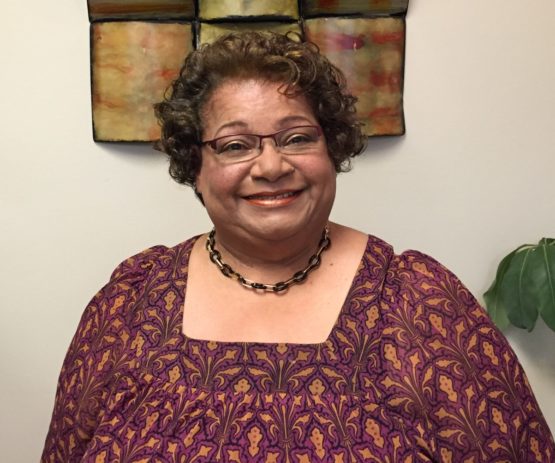April 14, 2020
Achieving Health Equity for Black Moms and Babies: A Conversation with Nurse-Midwife, Victoria Fletcher

WithinReach strives to create healthy, equitable and vibrant communities where all families have the opportunity to thrive. Yet, we know that this is not the reality for many, especially Black mothers and babies. According to a 2019 Centers for Disease Control and Prevention report, the Black maternal mortality rate is 3.3 times greater than that of white mothers – making this one of the widest racial disparities in healthcare today.
With 60 percent of these pregnancy-related deaths being preventable, many factors including access to quality health care, intergenerational trauma and lingering effects of slavery and racism within medicine may play a role in creating unsafe and life-threatening complications for Black mothers during and after childbirth. Although higher socio-economic status is usually associated with better health outcomes, this is not the case when looking at Black maternal mortality. According to a Vox article about Serena William’s childbirth experience, which shed light on the medical treatment of Black women: “Research has found that black women in higher economic brackets are still more likely than white women to die from pregnancy and childbirth-related problems.”
One thing is clear; we will not achieve the health and well-being of all Washington moms, until Black women have the same opportunity to thrive in pregnancy and childbirth. As a maternal health and family-focused organization, we hope to learn more and take action to eliminate the historically ignored and dismissed health barriers faced by Black women.
In preparation for this year’s Black Maternal Health Week, we had the opportunity to talk with certified nurse-midwife and former WithinReach board member, Victoria Fletcher, about her experiences as a midwife, working with Black mothers, and her thoughts on how organizations like WithinReach can eliminate racial disparities in maternal health.
Q & A with Victoria Fletcher, MSN, ARNP, FACNM
What motivated your interest in healthcare and improving access to care for others?
Growing up as a little girl in Detroit, Michigan, I used to accompany my mother to visit sick family members and friends at separate and not equal segregated hospitals. There was often a sense of despair in the air not only due to the severity of illness of the person, but also due to the knowledge that the health care they received was frequently substandard and their options for where they could receive care were limited.
This ignited a desire within me to become a healthcare professional who would deliver the best care to all, without regard for racial and socioeconomic status. I also had a strong desire to become a role model for young people in communities of color – to model that their career choices were not limited and that they too could become healthcare professionals. I wanted to use my talents and gifts to help uplift individuals and communities who struggle to access the basic health care that many take for granted.
Who inspired you to pursue a career in healthcare?
My uncle, Dr. H. Phillip Venable, a renowned ophthalmologist, professor and health advocate in St. Louis, MO was an inspiration to me. He was a pioneer in the treatment of glaucoma in African Americans and in corneal transplants. In addition, he established a scholarship fund to educate African American physicians in the specialty of ophthalmology. He encouraged me to pursue a career in healthcare.
My nursing professor, Dr. Mildred Disbrow, a nurse-midwife who had worked at the legendary Frontier Nursing Service in rural Kentucky, introduced me to the profession of nurse-midwifery. She sparked my interest in a profession that seemed like a perfect pathway for me to realize my dreams of making a real difference in the lives of people.
As well, Maude E. Callen, an African American registered nurse-midwife who served the residents of rural Berkeley County, SC for over 60 years. The health outcomes she achieved were astounding given the low resource environment and the poverty of her clients. Mrs. Callen and her work were featured in the December 3, 1951 edition of LIFE Magazine.
What kind of racial disparities did you experience or see during your time as a nurse-midwife?
I have been a nurse-midwife for over 43 years, and I wish I could say that I have not seen or experienced the impact of institutional racism, denial of access to quality care and cultural indifference in the provision of care for clients from communities of color during that time. However, unfortunately, that is not the case. Over the years, I have seen:
- A lack of cultural competency of staff caring for patients from communities of color. Care was dictated by assumptions, stereotypes and racial bias.
- A lack of interpreters for clients who did not speak English or had limited English proficiency.
- Aggressive obstetrical management and a lack of individualized, patient-centered birth plans.
- A lack of encouragement to breastfeed and encouragement for the use of formula feeding.
- Undocumented clients afraid to be admitted to the hospital, unless they were in advanced labor, for fear of being turned away or worse yet, deported.
- Drug screening of newborn infants of color and subsequent CPS (Child Protective Services) referrals for Black moms who had an illicit substance misuse disorder. Even though, there were no drug screening of newborn infants or CPS referrals for white moms who had a prescription substance misuse disorder.
- A lack of care coordination or planning for post-discharge challenges that moms and babies faced.
- Disregard for cultural and traditional health practices that were outside the conventional and westernized medicine viewpoint.
- Separate and not equal obstetrical wards. For instance, one ward would be for uninsured, low-income, mostly Black patients and a different ward would be for insured, mostly white patients. There would be disparate lengths of stay for the two wards: White patients stayed for three days postpartum and Black patients stayed for 24 hours or less. Some Black patients were never admitted to a bed, but rather labored in the hallway or an alcove.
What can community-based, family-focused organizations, like WithinReach, do to improve the health and health outcomes for Black moms and babies?
WithinReach’s mission and programs position the organization to make a real impact toward eliminating racial health disparities and improving health equity for Black mothers and babies. The organization has a long history of connecting families to vital services and resources essential for them to thrive. I commend WithinReach for its racial equity work including the publication of their racial equity statement and principles; the launch of a staff Diversity, Equity and Inclusion team; and the Board’s support for a strategic priority related to health equity. This work lays the foundation for WithinReach to push the envelope even further; to be on the leading edge to eliminate racial health disparities and to improve health equity for all moms and babies, but especially for Black moms and babies in Washington State.
How can we achieve health equity for all?
Acknowledge
- Acknowledge that access to care does not equate to quality care and that unequal treatment remains a stigma on the U.S. healthcare system, given the current rate of Black maternal mortality.
- Acknowledge the growing body of evidence that maternal stress during pregnancy, including stress due to racism, may lead to adverse effects in pregnancy and may have a lasting impact on the child throughout its life.
- Acknowledge that social determinants of health (the conditions in which people are born, grow, live, work and age) are major factors in determining health outcomes.
Work
- Continue work that supports diversity, equity and inclusion and brings the voices of those directly impacted to the table via collaboration and partnerships. Additionally, ensure that those directly impacted are integral players in determining methodologies that address racial health disparities and lack of health equity for Black moms and babies.
- Work to ensure that strategic priorities related to health equity have goals that will move the needle on improving health equity for Black moms and babies.
Support
- Provide support, both administrative and financial, to build the infrastructure and influence of grassroots organizations that share the mission to eliminate racial disparities and improve health equity for Black moms and babies.
Advocate
- Hold health agencies accountable for the quality of care provided to all moms and babies, including Black moms and babies.
- Advocate for service delivery models that are client-led, focused and include wraparound services essential to the wellbeing of Black moms and babies.
- Advocate for workforce development efforts that seek to increase the racial and ethnic diversity of the healthcare workforce.
- Monitor Washington State’s implementation of the December 2018 Preventing Maternal Deaths Act that support states in their work to save and sustain the health of mothers during pregnancy, childbirth and in the postpartum period.

Victoria Fletcher, MSN, ARNP, FACNM is a certified nurse-midwife and communities of color health care advocate. She is passionate about addressing issues of health equity, reproductive and social justice and reducing health disparities in underserved communities. Victoria currently works as a per diem clinician at Planned Parenthood of the Great Northwest and the Hawaiian Islands. She is a former lead surveyor and director of accreditation for Planned Parenthood Federation of America.
She serves on the board of the Washington Center for Nursing, Nurses for Sexual and Reproductive Health, Advisory Committee of the Washington Health Benefit Exchange. Victoria is a member of the American College of Nurse-Midwives (ACNM), Association of Women’s Health Obstetrical and Neonatal Nurses (AWHONN), Sigma Theta Tau and Ebony Nurses Association of Tacoma. She is a former Chair of the Washington State Board of Nursing and a former member and President of the board of WithinReach, where she served from 1990-2010.




